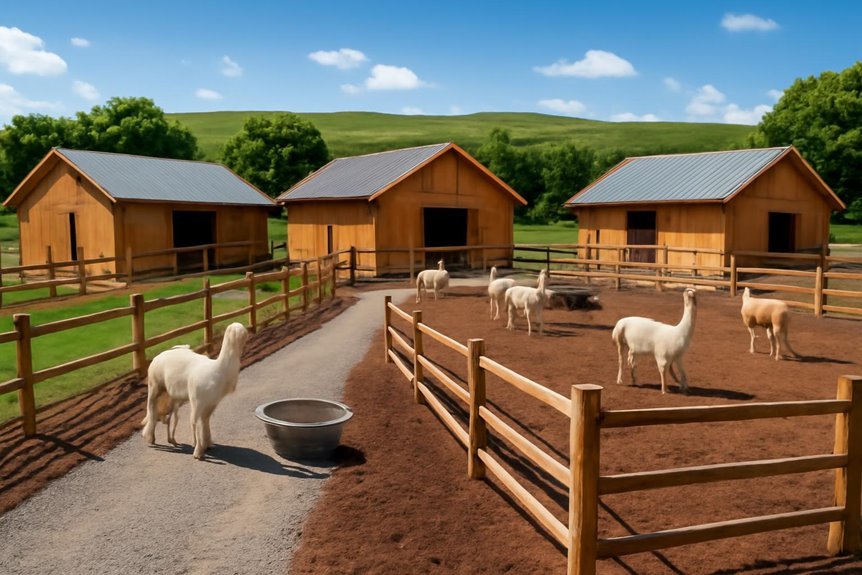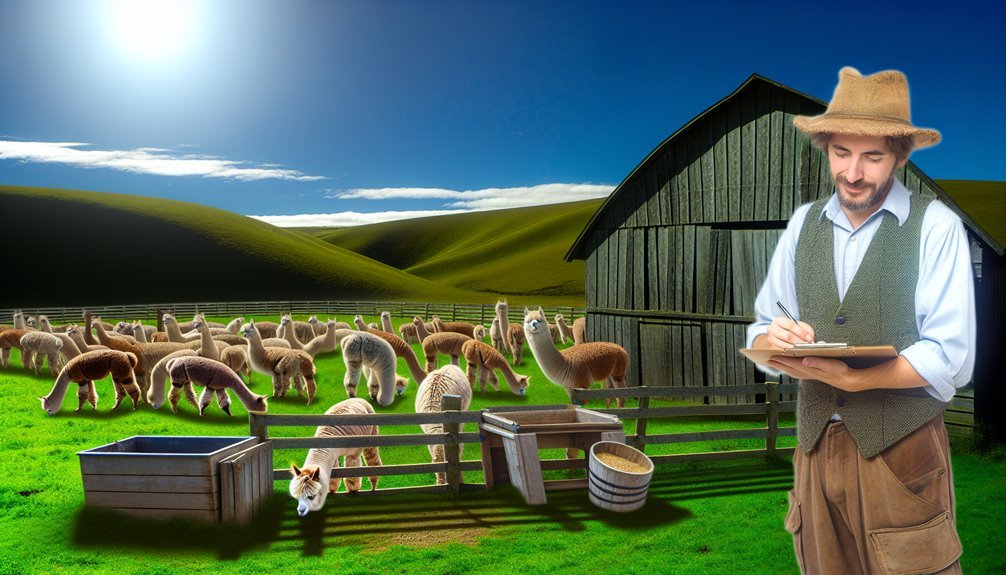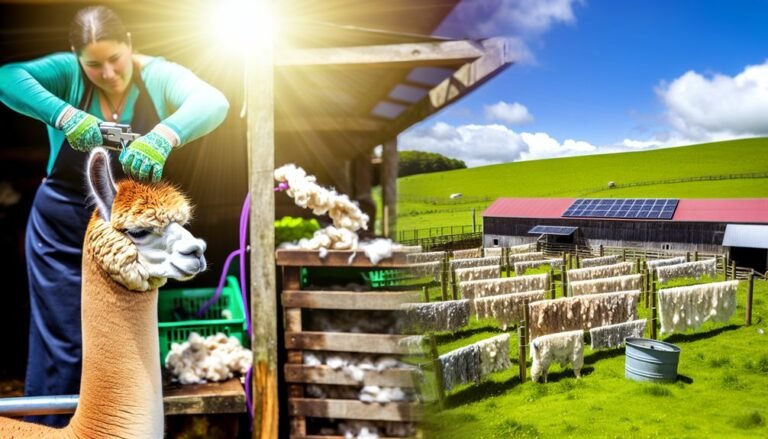Steps to Launch a Profitable Alpaca Farm
To launch a profitable alpaca farm, start by learning from experienced breeders and joining alpaca associations to gain insights and network. Develop a strong business plan based on market research, and select healthy alpacas with excellent fiber qualities. Invest in proper fencing, shelter, and nutrition, and maintain a clean environment. Use online and local marketing, build customer relationships, and collaborate with artisans. Follow these key steps, and you’ll be set up for success with more detailed guidance ahead.
Key Takeaways
- Research and learn from experienced breeders and industry experts to adopt best practices in alpaca care and management.
- Join alpaca associations to access resources, network, and stay updated on industry trends and marketing opportunities.
- Develop a detailed business plan with market research, financial projections, and select high-quality alpacas with superior fiber traits.
- Maintain a clean, safe environment with proper nutrition, health care, and regular shearing to ensure alpaca well-being and product quality.
- Build strong customer relationships, collaborate with local artisans, and host events to promote products and enhance brand loyalty.
Researching and Learning From Experienced Breeders

Before you start your alpaca farm, visiting local farms and attending shows is essential to see firsthand how experienced breeders manage their animals and operations. Visiting local alpaca farms lets you observe best practices in breeding and health care directly from seasoned farmers. Engaging with industry experts at these events provides valuable advice tailored to your goals. Participating in hands-on activities builds your confidence in handling alpacas and understanding their needs. Leveraging resources from reputable alpaca associations—like workshops and educational materials—further enhances your knowledge about both animal care and business strategies. Regular communication with experienced breeders creates a supportive community that encourages continuous learning and helps you stay current with industry trends and best practices, laying a strong foundation for your profitable alpaca farm.
Joining Alpaca Associations and Networking
While growing your alpaca farm, joining alpaca associations like the Alpaca Owners Association (AOA) or the British Alpaca Society (BAS) can be a game changer. These memberships give you access to essential industry updates and educational resources that improve your herd’s fiber quality and overall management. Joining alpaca associations also opens valuable networking opportunities with experienced breeders, letting you exchange best practices and gain insights that boost profitability. You’ll benefit from association events and alpaca shows, where you can learn from judges and experts about quality standards. Plus, many associations offer promotional support, helping market your products and connect with customers. Staying connected through these groups guarantees you’re informed about regulatory changes and market trends critical for your farm’s success.
Visiting Alpaca Farms and Shows
When you visit alpaca farms, you get to see firsthand how successful farmers manage their animals and operations. Attending shows is a great way to meet experienced breeders and learn from industry experts. These experiences can help you build connections and improve your own farm’s practices.
Observing Farm Operations
Anyone interested in alpaca farming should consider visiting local farms and attending shows to see operations up close. Observing farm operations firsthand lets you understand daily animal care, veterinary care, and fiber production techniques that contribute to a successful herd. To get a well-rounded perspective, visit as many farms as you can and attend various shows. This exposure helps you learn about breed characteristics and quality standards, enabling informed decisions when selecting alpacas. While networking is important, focus on absorbing practical knowledge during your visits. Watching how experienced farmers manage their operations offers valuable insights into nutrition, shearing, and overall farm management. By doing so, you’ll be better equipped to launch and maintain a profitable alpaca farm based on tried-and-true practices.
Networking at Shows
Because alpaca shows gather farmers, breeders, and experts in one place, they offer a unique opportunity to network and deepen your understanding of the industry. Attending alpaca shows lets you observe judges’ evaluations and see award-winning alpacas, giving you clear benchmarks for selecting quality breeding stock. By networking with experienced breeders and other farmers, you’ll tap into valuable knowledge about animal care and farm management. Visiting local farms before starting your own operation also reveals the day-to-day realities of alpaca farming. Engaging with the alpaca community at shows builds a support network that’s essential for maneuvering challenges in this niche market. These connections and firsthand experiences equip you to launch a profitable alpaca farm with confidence.
Developing a Comprehensive Business Plan
You’ll want to start by analyzing the market to understand your competition and spot potential customers for your alpaca products. Next, plan out your financial projections carefully, including startup costs and ongoing expenses, to see when your farm can turn a profit. This groundwork helps you build a solid business plan that guides your farm toward success.
Market Analysis Essentials
While launching an alpaca farm can be rewarding, developing an extensive business plan is crucial to guide your efforts and secure investment. Start with thorough market research to identify demand for alpaca fiber, selling breeding stock, and other products. Understanding your local competition by visiting farms and shows helps shape your pricing and marketing strategies. Your business plan should clearly define your mission, target market, and operational approach, highlighting potential revenue generation from raw fleece, finished goods, and stud services. Incorporate a break-even analysis to estimate when your alpaca business will become profitable. By combining detailed market insights with realistic financial projections, your business plan becomes a significant roadmap that attracts investors and guarantees your farm’s long-term success.
Financial Projections Planning
When developing your alpaca farm’s business plan, financial projections play an essential role in mapping out your path to profitability. You’ll need to detail startup costs like purchasing alpacas and setting up infrastructure, alongside ongoing expenses such as feed, veterinary care, and shearing. Forecasting financial returns from fleece sales and breeding services helps you anticipate income and manage cash flow effectively. Including a break-even analysis reveals when your total revenues will cover costs, guiding your timeline for profitability. Tracking seasonal fluctuations guarantees your budget remains realistic throughout the year. Don’t forget to outline your mission and marketing strategies to support these projections. Consulting an accountant experienced in agricultural businesses can streamline bookkeeping and tax planning, making your alpaca ownership venture financially sustainable and successful.
Selecting Quality Alpacas and Planning for Health Care
Because the quality of your alpacas directly impacts both your product and profits, selecting animals with superior fiber traits like density and fineness should be your top priority. When selecting quality alpacas, look for those with proven superior fiber characteristics from farms with strong health management practices. Confirm they’ve received consistent veterinary care, including vaccinations and deworming. Establish a relationship with a camelid-experienced vet for ongoing health support. Meeting your alpacas’ dietary needs is essential—provide high-quality hay, camelid-specific minerals, and fresh water to maintain their wellbeing and fiber quality. Don’t forget to implement a reliable shearing schedule, typically once a year before warm weather, to boost fleece quality and prevent overheating. These steps will help you build a healthy, productive herd ready to maximize your farm’s profitability.
Establishing Farm Infrastructure and Proper Fencing

After selecting healthy alpacas and planning their care, you’ll need to focus on building a safe and comfortable environment. Establishing farm infrastructure starts with constructing a three-sided shelter, providing 10-12 square feet per alpaca to meet their needs for ventilation, dryness, and protection. Proper fencing is essential—use sturdy woven wire, 4.5 to 5 feet tall, combined with no-climb fence designs to prevent escapes and keep predators out. Adding electric wire can enhance security against coyotes or bears. Maintain a clean environment by regularly inspecting and repairing fences and shelter, removing toxic plants, and ensuring good drainage in pens. Prioritizing these steps supports the health and comfort of your alpacas, laying a strong foundation for a profitable farm.
Marketing Strategies and Building Customer Relationships
How can you make your alpaca farm stand out in a crowded market? Start by developing smart marketing strategies that combine online platforms like social media and a dedicated website with offline efforts, such as attending local fairs and alpaca shows. Highlight the unique qualities of your alpaca products—like their eco-friendliness and luxurious feel—to educate customers and differentiate your brand. Building strong customer relationships is key, so offer exceptional service, stay in touch through email marketing, and provide post-purchase support. Collaborate with local artisans to create exclusive items and host farm tours or workshops, enriching your brand’s appeal. These strategies not only attract new customers but also foster loyalty, ensuring your alpaca farm thrives in a competitive marketplace.
Frequently Asked Questions
How Much Money to Start an Alpaca Farm?
You’ll need to contemplate initial investment costs, ongoing expenses analysis, equipment and supplies, insurance requirements overview, land acquisition considerations, financing options available, and revenue generation strategies to start an alpaca farm successfully and sustainably.
How Many Alpacas Do You Need to Be Profitable?
You’ll need at least 5-10 alpacas to balance breeding strategies and herd management effectively. Focus on fiber quality, market demand, pricing models, and veterinary care to maximize profit margins and guarantee your farm’s profitability.
Is Owning Alpacas a Tax Write-Off?
Owning alpacas can be a golden goose for tax benefits if you’re structured right. You can claim farming deductions on alpaca expenses, operating costs, and livestock classification, lowering your income tax through proper business structure and careful record-keeping.
How Many Alpacas Are on 1 Acre?
You can keep about 10-15 alpacas per acre with proper pasture management and feeding guidelines. Consider alpaca breeds, fencing requirements, health care, breeding practices, and market demand for a successful, well-maintained herd.








Our picks
Alpaca & Wool Felted Sole Inserts: Comfy Upgrade?
Best Alpaca Socks for Hiking: Ultimate Comfort and Durability on Trails
Best Alpaca Halter for Comfort and Control